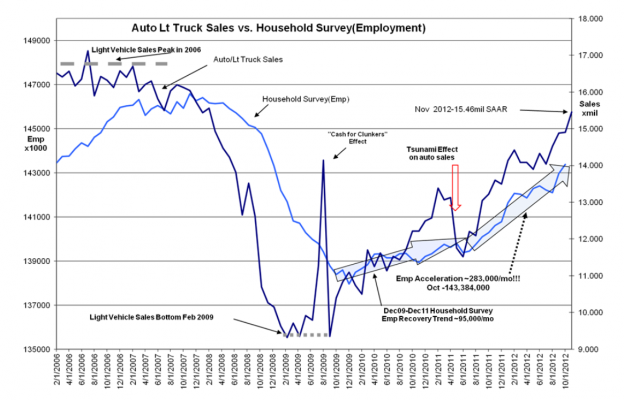“Davidson” submits:
The Nov 2012 Auto&Lt Vehicle Sales were reported by companies throughout yesterday with the final tally coming to 15.46Mil SAAR(Seasonally Adjusted Annual Rate). As one can see in the chart this continues the previous trend. While this level of sales certainly has been boosted by the replacement of damaged vehicles wrought by Hurricane Sandy and the one could argue that a somewhat slower trend may occur in future months as vehicle sales pare back this effect, the trend in place since early 2009 should remain intact. Auto sales have always been a good harbinger of the employment trend and this data supports positive employment gains in future months.
Expanding economic activity has always resulted in higher stock prices ($SPY) and this time has no reasons to be different from the past. The “Fiscal Cliff” is not something which either political party wants to wear as a negative outcome in the next election and an accommodation will occur even if it does not occur till several months into 2013. You should expect this process to be messy with some volatility in the markets!
History has only one instance of a tax increase being partially blamed for a recession and this was in 1937. The issues of this period have been laid out by Paul Kasriel in an on line article with charts called “The-great-depression-just-the-facts-maam”. The taxes for upper income earners went from 63% to 77% (a 22% increase), but even with the previous (1932) 150% tax increase to 63% on this same group of earners there was a highly visible recovery under way in 1936. What really impacted economic growth was the implementation of a requirement to double bank reserves! Lending rapidly slowed and so did the pace of the economy. The economy slipped directly into the jaws of another recession!
The current cry and hue that the sudden reimposition of higher taxes as leading to another recession does not have the support of history. History indicates that recessions are more tightly linked to the sudden onset of bank lending restrictions. The Volcker quashing of inflationary psychology in 1981-82 was the same effect as lending rates soared to nearly 20% overnight.
Bank lending today is already tight. It could get tighter, but Bernanke has already indicated lending as being too tight today. Today’s tight lending restrictions is one of our problems and therefore one would not expect additional tightening in an environment where it is mostly prime borrowers(those who can pay cash for homes) who are getting mortgage loans at the moment. With a housing recovery in progress, regulators are far more likely to loosen underwriting standards as they become more not less comfortable with associated employment trends.
I expect that the “Fiscal Cliff” even if there is no agreement and automatic cuts and tax increase do occur to have little impact on the current pace of the recovery. The only caveat is the direction of bank lending. Should regulators suddenly cause greater restriction in lending, then expectations for an economic slowing would rise sharply. At the moment I do not see any reason why banks should tighten any further than they already have. If anything, Bernanke will be pushing regulators for lending standards closer to historical norms.
The “Fiscal Cliff” and the forecasted economic collapse by the media has all the appearances of being close to a non-event. What matters most are bank lending standards which are currently too tight. What should be heartening is that even with tight lending, our economy is moving steadily forward, auto sales hitting new 4yr highs, new home sales rising at a brisk pace, retail sales at a brisk pace and all time high and all the signs for economic growth moving in coordinated uptrends.
This is a good time in my estimation to take advantage of any market fears and add to accounts.

One reply on “Auto Sales and Employment”
[…] Strong auto sales are pointing towards employment growth. (ValuePlays) […]